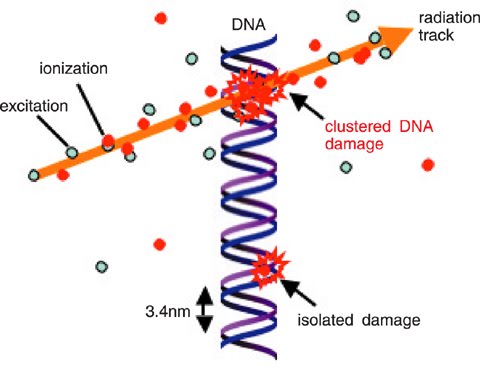WP3 – Radiobiology
 WP3 of FranceHADRON focuses on radiation biology, the study of biological effects of ionizing radiation on living organisms and cells.
WP3 of FranceHADRON focuses on radiation biology, the study of biological effects of ionizing radiation on living organisms and cells.
Involved partners are: the IPNL (Lyon), LPC Clermont, IRSN, the EMR3738 (Lyon), the U562 (Toulouse) the UMR6232 (Caen), the U612 (Orsay), ICPO, the U1030 (Villejuif), the CREATIS (Lyon) and LARIA (Caen)
WP 3.1- Methods for radiobiological data acquisition, processing, analysis, modelling:
The methods are mastered and the preliminary work has been ongoing for the past 2 years.
By mid-2015, the deliverables will be:
1) Development of a cellular irradiation system for protons (1-3 MeV) including impact tracking of protons via imaging and physical methods;
2) upgrading of an open-source Monte Carlo simulation program (Geant4DNA) to describe the physical and chemical early stages following the impact of ionizing particles in a cell with microscopic resolution which will lead to the simulation of direct and indirect DNA damage;
3) correlations between the clusters of energy deposits simulated by MC code and the observed foci obtained using high-rate computerized acquisition microscopy platforms in different human tumour cell lines irradiated with carbon ions and protons at different LET. This work has links with WP2.
Tentative plans beyond 2015: development of RBE models for TPS, based on the Micro Kinetic Model and new approaches involving nanodosimetry and oxidative stress simulation.
WP 3.2.1- Radiobiological approach of combined or sequential hadrontherapy:
The aim is to develop protocols combined with Hadrontherapy through studies of the effect of chemotherapy or an associated targeted therapy (temozolomide, platinum salts, EGFR inhibitors, etc.) or sequential protocols involving photon and then hadron therapy in different tumour models (glioblastome, ORL, in vitro and in vivo). The results will enrich simulation codes (WP3.1) and serve as a basis for hypotheses of pre-clinical and clinical trials (WP1).
Delivrables:
- Late 2014 knowledge of DNA damage, cellular survival and death, transcriptomic and methylomic analyses;
- Late 2015 : First results in animal models orthotopic glioblastoma tumours and metastasizing chondrosarcoma.
WP 3.2.2- Influence of hadron therapy on recurrence, angiogenesis and metastasis:
The aim is to validate using tumour cell models, cancerous stem cells (HNSCC, glioblastome) and animal models, the reduction in risk of metastasis and recurrence in response to carbon ions compared to protons and photons. This work will depend on WP2.2 for RBE reference values.
Delivrables:
- Late 2014: Study of radioresistance and cellular migration mechanisms as a function of the type of ionizing radiation (migration and invasion test, signalling pathways, integrins, cadherins, Rho-GTPases) in cellular models;
- Late 2015: implementation of in vivo studies of orthotopic, metastasizing tumours irradiated by hadron therapy, in comparison with irradiation with photons and protons with different fractionation schemes.
WP 3.2.3- Prediction of tumour response:
In vitro and in vivo studies will be carried out to predict the tumour response given a panel of tumour biomarker.
Delivrables:
- Milestone: 2014,
1) validation of biomarkers from biomarker candidates (proposed during previous work) using immuno-histochemistry and/or Q-PCR analysis on human tumour cells in vitro, ex-vivo and in biopsies. A relationship with biobanks will be established.
2) Implementation of an associated biological study (Lyric) associated with the randomised trial called PHRC-ETOILE / HIT (see WP1) for cystic adenoid carcinoma and sarcomas, potentially 250 cases from 2012 to 2016.
WP 3.3.1- Individual susceptibility and DNA damage repair and signalling:
Delivrable: extension to hadron therapy of studies on individual susceptibility to ionising radiation also undertaken with human fibroblasts and astrocytes of different radiosensitivity.
- 1st milestone: 2013, relationship between energy and nucleo-shuttling of pATM (PhD studies ongoing);
- 2nd milestone: 2014, relationship between pATM expression, tissue type and DNA repair. Estimation of the bystander effect;
- 3rd milestone: 2015, correlation with the CTCAE scale and repair/signalling.
WP 3.3.2 Toxicity of hadrons on healthy tissues:
Delivrable: evaluation of the ratio the nature and the kinetics of complications induced by hadron therapy in a mouse C57B l6 model.
- 1st milestone: 2013, semiotic analysis, in vivo imagery (PET and IVIS) and anatomic-pathology of the appearance of early and late complications;
- 2nd milestone: 2014, consequences of the invalidation of signalling pathways TGF-β and Rho in transgenic mouse models in terms of acute, chronic, neurotoxic and neuro-degenerative inflammatory processes;
- 3rd milestone: 2015, establishment of the RBE of tissue components (endothelial cells, fibroblasts, smooth muscle tissues, brain cells, etc.). Complementary photon and then carbon irradiation (top-up) at different stages of the development of tissue damage.
WP 3.3.3- Risk of hadron-induced cancer:
Delivrable: Understanding and quantified risk analysis of radio-induced carcinogenesis by protons/carbons versus photons in cancer prone mouse models p53 heterozygote Balb/C.
- 1st milestone: 2013, correlation between physical parameters (dose rate, neutron emission, activation) and the induction of radio-induced cancer in animal models;
- 2nd milestone: 2014, effect of proton/carbon/photon fractioning and targeting (base of skull and/or mammary gland) on tumour induction;
- 3rd milestone: 2015, end of the study of irradiated animals and analysis of data. Comparison between in vivo data, patient cohorts and induced carciongenesis risk models.
Contact : Claire Rodriguez-Lafrasse, Lyon.
Events
June-5th 2015: WP4 meeting in Lyon
May-11th 2015 : Steering-commitee meeting in Paris
April-15th 2015: WP1 meeting in Orsay
Module-Workshops and international meeting
May 18-23 2015: 54th PTCOG - Manchester Grand Hyatt, San Diego, California







